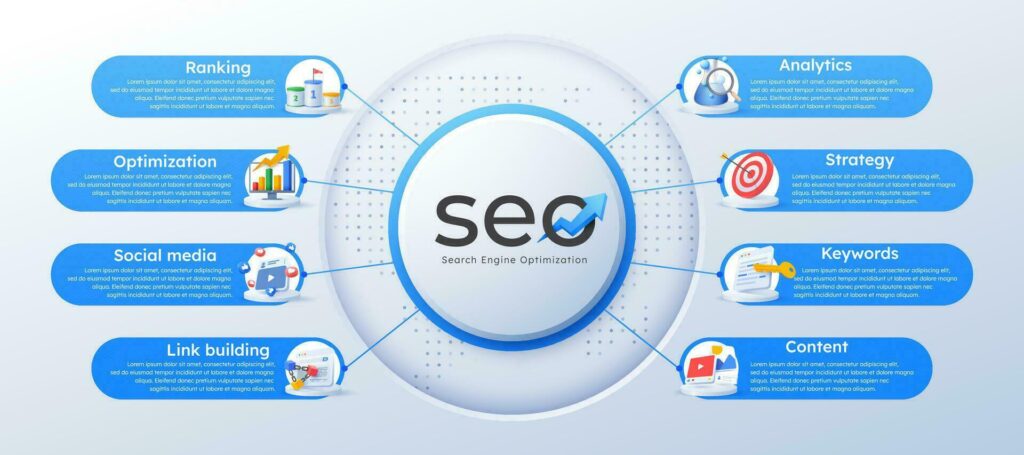Key Strategies for Optimizing Website Performance: UX, SEO, Blog Posts, and Design
In the competitive digital marketplace, a website must stand out by offering an exceptional user experience, ranking well in search engines, and having an appealing design. Achieving these goals requires a comprehensive approach, incorporating best practices in four critical areas: Website User Experience (UX), Blog Posts, Search Engine Optimization (SEO), and Website Design. Below, we’ll explore effective strategies in each of these areas and discuss how they can work together to boost a website’s performance and user engagement.

Enhancing Website User Experience (UX)
User experience (UX) encompasses all aspects of how visitors interact with a website and how those interactions make them feel. A strong UX design ensures that visitors can easily navigate the site, find the information they need, and complete desired actions without frustration. Key elements of effective UX include:
- Clear Navigation: Websites should feature intuitive, easy-to-follow menus that guide users toward their destination quickly. Simplified navigation helps users locate the content or services they need with minimal effort (Patel, 2023).
- Optimized Load Times: Speed is a significant factor in user satisfaction. Studies show that slow loading times contribute to high bounce rates, especially on mobile devices. Google reports that 53% of users will abandon a site if it takes longer than three seconds to load (Google, 2018). Ensuring that media files are optimized for quick loading can dramatically reduce abandonment.
- Mobile-Friendly Design: With a growing number of users accessing websites via smartphones, mobile optimization is a must. Websites need to adapt seamlessly to different screen sizes, offering a consistent and enjoyable experience on mobile, tablet, and desktop (Patel, 2023).
- Accessibility for All Users: A website that is designed with accessibility in mind ensures it is usable by individuals with disabilities. This includes compatibility with screen readers, easy navigation for keyboard users, and ensuring that all images are appropriately labeled with alt text (Forbes Council, 2023).
Blog Posts
Blogging is an effective tool for driving traffic, building brand authority, and engaging visitors. Best practices for creating impactful blog content include:
- Catchy Headlines: A compelling headline grabs attention and encourages users to click through and read the full post. An effective headline should be informative, engaging, and hint at the value the reader will get from the content (Patel, 2015).
- Organized Structure: Breaking up content with headings, subheadings, and short paragraphs makes it easier to read and digest. Users are more likely to stay engaged if they can quickly scan the post to find the information they’re looking for (HubSpot, 2021). This approach not only helps with user experience but also makes the content more digestible.
- Engaging, Relevant Content: The content should address the needs, interests, and problems of the target audience. Offering practical solutions, valuable insights, or answering common questions ensures the content resonates and provides real value to readers (Patel, 2015).
- Effective Calls to Action (CTA): Every blog post should conclude with a clear CTA that directs readers to further actions, such as subscribing to a newsletter, reading additional posts, or even making a purchase. A well-placed CTA can significantly increase engagement and conversion rates.
Search Engine Optimization (SEO)
SEO is a critical component of online visibility. It involves optimizing a website’s content and structure to rank higher in search engine results, driving organic traffic. Here are some essential strategies for improving SEO:

- On-Page SEO Optimization: Properly optimizing page titles, meta descriptions, and headers with relevant keywords is crucial for improving search engine ranking. However, keyword stuffing should be avoided; the key is to naturally incorporate keywords where they make sense within the content (Patel, 2015). Quality content that satisfies search intent is favored by search engines.
- Mobile Optimization for SEO: With mobile-first indexing now a priority for Google, ensuring that your website is mobile-friendly is more important than ever. A responsive site not only improves the user experience but also boosts search rankings (Patel, 2015).
- Building Quality Backlinks: High-quality backlinks from authoritative sites can significantly improve SEO rankings. These links act as “votes of confidence” in your content. To generate backlinks, create valuable, shareable content that other sites will want to link to (Patel, 2015).
- Content Relevance and Quality: Research by Moz highlights that search engines prioritize content that matches user search intent. Websites that offer in-depth, relevant, and well-structured content that answers users’ questions are more likely to rank highly in search results (Moz, 2022).
Website Design
A website’s design is essential for capturing attention and retaining visitors. An effective design ensures that users have an enjoyable experience while navigating through the site. Some design best practices include:
- Minimalist and Clean Design: Keeping the design simple and free from clutter helps users focus on what matters most. A minimalist approach improves user engagement by reducing distractions and making content easy to find (Forbes Agency Council, 2023). Simplified layouts are also faster to load, which contributes to an overall positive experience.
- Consistency in Branding: Consistent use of fonts, colors, and design elements helps reinforce the brand’s identity. A cohesive look throughout the site makes it feel professional and polished, which instills confidence in users (Forbes Council, 2023). Consistency also aids navigation, allowing users to feel more familiar with the interface on repeat visits.
- Interactive Features: Subtle animations, hover effects, and interactive elements can enhance the user experience, but they should be used sparingly to avoid overwhelming visitors. Properly balanced interactive features can create a more engaging and dynamic website (Patel, 2023).
- Responsiveness Across Devices: A responsive website automatically adjusts its layout depending on the device being used. As more users access websites from mobile devices, it’s critical to ensure that the design is flexible and user-friendly on all screen sizes (Forbes Agency Council, 2023).
For further inspiration, check out this Pinterest page on website design:

Summary
To build a successful website, focusing on user experience, SEO, content, and design is essential. A website that prioritizes clear navigation, fast loading times, valuable content, and responsive design will engage visitors and improve online visibility. By implementing these best practices and staying up-to-date with industry trends, businesses can enhance their website’s performance and achieve long-term success.
References
- Forbes Council. (2023, August 8). 10 Key rules to improve your website’s user experience. Forbes. https://www.forbes.com/councils/theyec/2023/08/08/10-key-rules-to-improve-your-websites-user-experience/
- Neil Patel. (2023). UX best practices for an improved user experience. Neil Patel. https://neilpatel.com/blog/ux-best-practices/
- Forbes Agency Council. (2023, February 3). 5 best practices for designing effective B2B homepages. Forbes. https://www.forbes.com/councils/forbesagencycouncil/2023/02/03/5-best-practices-for-designing-effective-b2b-homepages/
- Neil Patel. (2015, July 9). The single marketing practice that will make you win in Google’s search results. Forbes. https://www.forbes.com/sites/neilpatel/2015/07/09/the-single-marketing-practice-that-will-make-you-win-in-googles-search-results/
Hi Jake,
My first impression of your blog post on web best practices is that it looks and feels clean, informative, and highly user-friendly—great for personal and professional reference. Your use of bullet points does a nice job of breaking up the content, making it easy to digest and navigate.
I also appreciated the inclusion of the YouTube video—it adds depth to the content—and the clickable Pinterest icon is a smart touch for added interactivity. There’s not much I would change, but in the future, incorporating a few more visual elements or a bit of color could help keep visitors even more engaged and potentially encourage them to stay longer.
Wishing you all the best,
Eli Cosand
Hi Jake!
This was a great blog post! You hit all the points of digital best practices and explained them. I loved the diversity in different media used to further support your explanations. Pictures are very appealing and easy to use, but you went above and beyond with a video, graph, and even a link to a Pinterest board, excellent! Something could strengthen the visibility of your blog would be adding in color. You could have the all the headers in a different color other than black to highlight when there is a new topic being discussed.
All in all, this was a very professional and well written blog post, great job! Keep up the good work, I am very excited to read your next blog post.